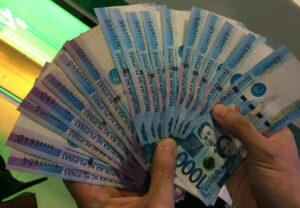Banks’ NPL ratio steady at 3.38% in Feb.
THE PHILIPPINE banking industry’s gross nonperforming loan (NPL) ratio remained steady in February, according to data from the Bangko Sentral ng Pilipinas (BSP). Preliminary data from the central bank showed the bad loan ratio stood at 3.38% in February, the same as January. On the other hand, it was lower than 3.44% in the same […]

THE PHILIPPINE banking industry’s gross nonperforming loan (NPL) ratio remained steady in February, according to data from the Bangko Sentral ng Pilipinas (BSP).
Preliminary data from the central bank showed the bad loan ratio stood at 3.38% in February, the same as January. On the other hand, it was lower than 3.44% in the same month in 2024.
Loans are considered nonperforming once they remain unpaid for at least 90 days after the due date. These are deemed as risk assets since borrowers are unlikely to pay.
The amount of nonperforming loans inched up by 0.1% to P513.35 billion in February from P512.83 billion in January. Year on year, soured loans jumped by 10.1% from P466.11 billion.
The total loan portfolio of the banking system slipped to P15.173 trillion from P15.176 trillion a month ago. However, it climbed by 12.1% from P13.54 trillion a year earlier.
Past due loans stood at P637.81 billion in February, up by 0.7% month on month from P633.1 billion. It likewise increased by 9.2% from P584.23 billion in the same month in 2024.
This brought the past due ratio to 4.2%, higher than 4.17% in January but lower than 4.31% a year ago.
Restructured loans dipped to P311.11 billion in February from P311.22 billion a month prior. Year on year, it went up by 6.5% from P292.1 billion.
Restructured loans accounted for 2.05% of the industry’s total loan portfolio, steady from January and lower than 2.16% a year ago.
Banks’ loan loss reserves inched up by 0.2% to P489.55 billion in February from P488.48 billion in the previous month and increased by 5% from P466.39 billion a year earlier.
This brought the loan loss reserve ratio to 3.23% in February from 3.22% in January and 3.44% in 2024.
Lenders’ NPL coverage ratio, which gauges the allowance for potential losses due to bad loans, rose to 95.36% in February from 95.25% in January but dipped from 100.06% a year ago.
Rizal Commercial Banking Corp. Chief Economist Michael L. Ricafort said the steady NPL ratio was largely due to the faster growth in loans that broadened the base.
This would also “reflect a corresponding growth in NPLs in the numerator, thereby mathematically keeping the said NPL ratio steady,” he added.
Separate BSP data showed bank lending growth slowed to 12.2% in February from the 12.8% expansion in January, which was the fastest in two years.
Year on year, the growth in lending was faster than the 8.7% increase in February 2024.
“The steady NPL ratio also reflects better management of credit risks amid faster loan growth in recent months,” he added.
Mr. Ricafort said lower interest rates since late last year also eased the debt burden for borrowers.
The central bank began its easing cycle in August last year, slashing borrowing costs by a total of 75 basis points (bps) and bringing the rate to 5.75% by end-2024.
“Possible further Fed and local policy rate cuts in the coming months would also help improve the NPL ratio,” he said.
Despite keeping rates steady in February, the BSP is widely expected to resume easing at its policy-setting meeting today (April 10.)
A BusinessWorld poll conducted last week showed that all 17 analysts surveyed expect the Monetary Board to reduce the target reverse repurchase rate by 25 bps.
If realized, this would bring the benchmark rate to 5.5% from the current 5.75%.
On the other hand, Mr. Ricafort flagged risks such as the United States’ recent reciprocal tariffs, which could slow growth, investments and business activities.
This could “reduce sales, incomes, and ability to pay by some borrowers,” he added.
US President Donald J. Trump’s reciprocal tariffs on the country’s trading partners took effect on Wednesday (April 9), deepening the global trade war.
The Philippines was slapped with a tariff rate of 17%, though this was the second lowest in Southeast Asia, just after Singapore, which received the 10% baseline tariff.
“Employment data among the best in 20 years or since revised records started in 2005 would continue to support the continued growth in consumer loans and overall loans, while also leading to more incomes that support the ability to pay by some borrowers,” Mr. Ricafort said.
The latest data from the local statistics authority showed the jobless rate dropped to a two-month low of 3.8% in February. The underemployment rate likewise fell to a nine-month low of 10.1%. — Luisa Maria Jacinta C. Jocson























